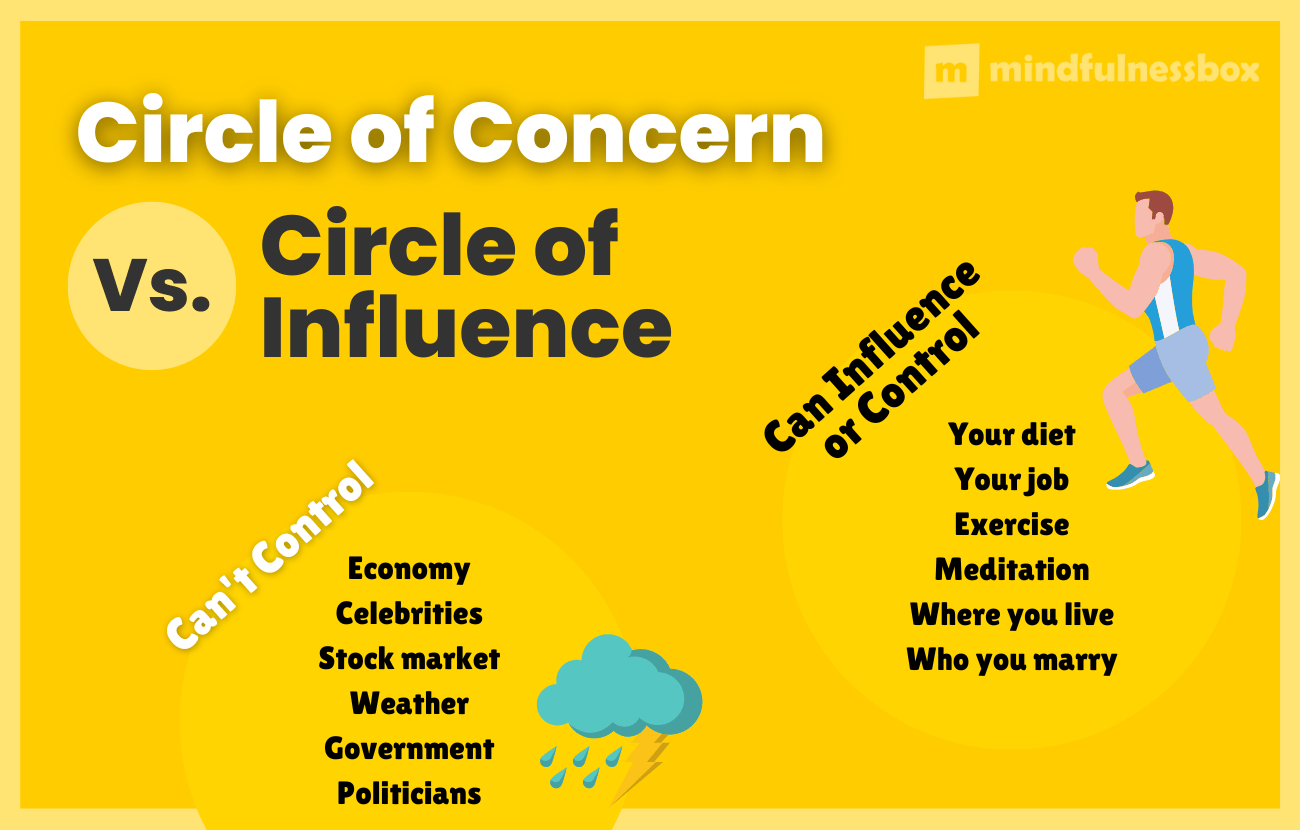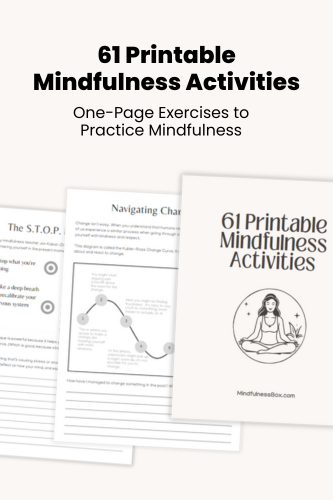Understanding the circle of influence vs circle of concern means understanding what we can control, and what we can’t control. The Circle of Concern, Circle of Control, and Circle of Influence deal with exactly this issue. These concepts come from Stephen Covey’s 1989 book ‘The 7 Habits of Highly Effective People’.
It’s tough to accept that there are some things we care about that we can’t change.
We live in a world where we’re encouraged to pay attention to things happening thousands of miles away. We’re bombarded on all sides with worthy causes to support.
Get dozens of one-page exercises to help practice mindfulness, meditation, gratitude, and self love. Perfect for printable handouts when teaching mindfulness to groups, students, or in the workplace.
To see examples, plus a full list of the 61 exercises included, click below.
Worthy though these causes may be, we need to acknowledge that our attention is limited. With limited energy and attention, we’re best served by understanding the things we can have an impact on, and the things we can’t.
The concept of the Circle of Concern and Circle of Influence deals with exactly this issue. It comes from Stephen Covey’s 1989 book ‘The 7 Habits of Highly Effective People’.
Let’s break each down below, and explore how this concept might help you.
Circle of Concern vs Circle of Influence
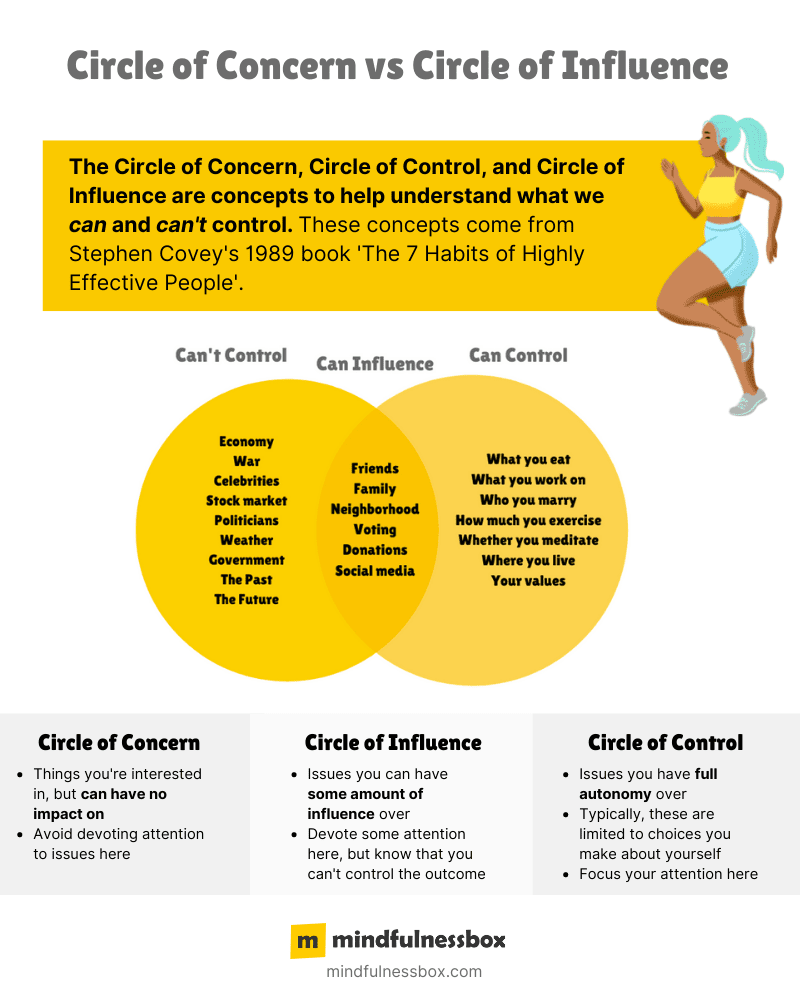
The main difference between the Circle of Influence and Concern is that you can’t affect issues in your Circle of Concern, but you can affect issues in your Circle of Influence.
There’s also the Circle of Control, which is the part of the Circle of Influence that you have 100% control over. Typically, this includes only things pertaining to you: your thoughts and your actions.
Below is a graphic illustrating this concept. The idea is that as you get further towards the core, that’s where you should focus your attention. Issues on the edges of this circle don’t deserve your focus, because you can’t influence them.
Here’s what that looks like:
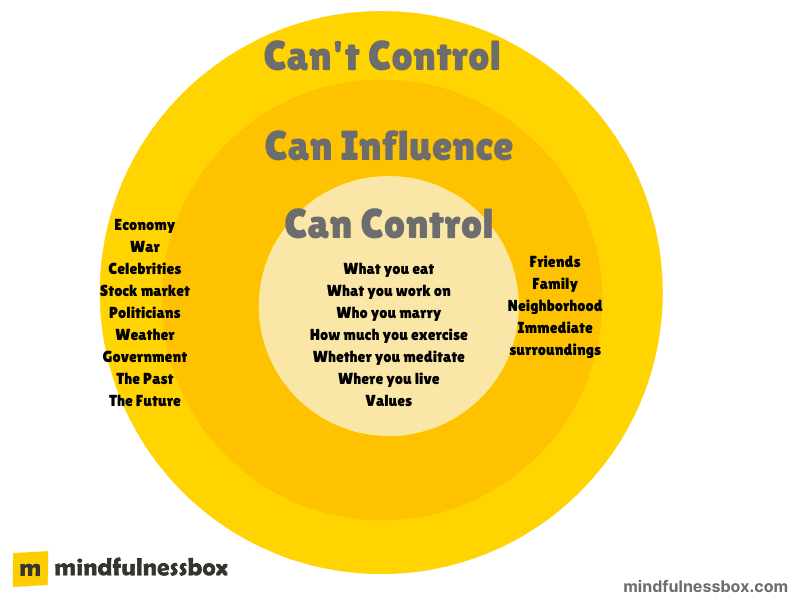
Understanding what you can control, and what you can’t
The traditional “Circle of Influence” graphic in the section above isn’t that clear to me, so I spun up a Venn Diagram version and used some clearer language that gets straight to the point:
There are things you can control, things you can influence, and things you can’t control.
Here’s what that looks like:
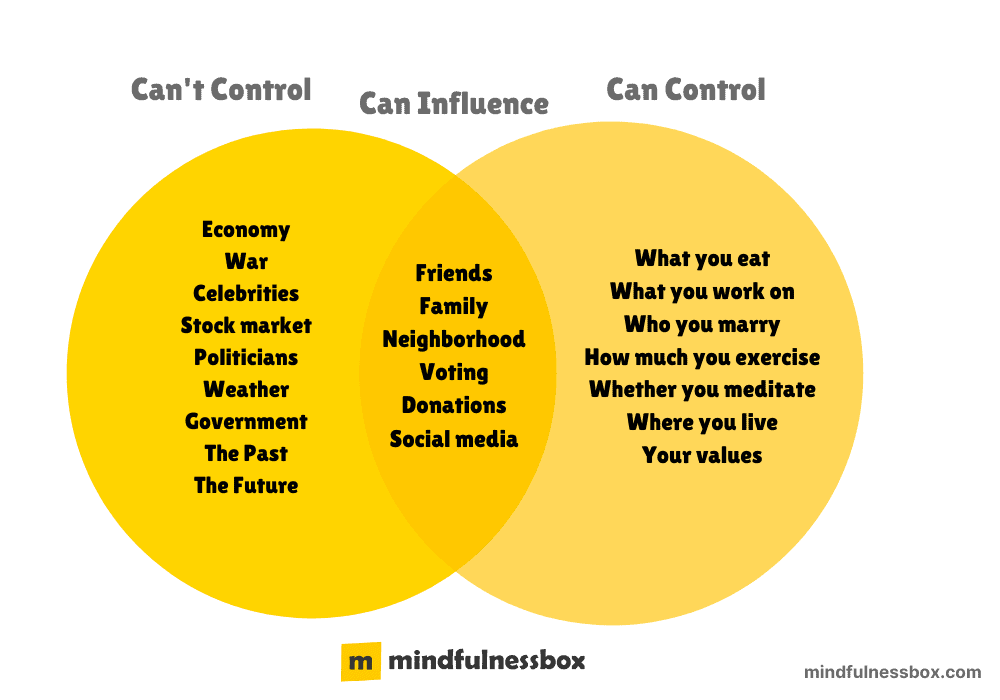
Sometimes, the actions you take can extend your influence beyond yourself. That’s the circle of influence. But there’s still a wide swath of issues you can never have any control over.
Your task is to notice the difference between the three, and focus as much of your energy on the things you can control and influence as possible.
Let’s explore each individually.
What is your Circle of Concern?

Your circle of concern includes everything in the world that you have a personal interest in, from government policy, to climate change, to whether your favorite sports team wins. Although these issues may affect your daily life, you typically have no way to influence them directly.
Here’s what it looks like for many of us:
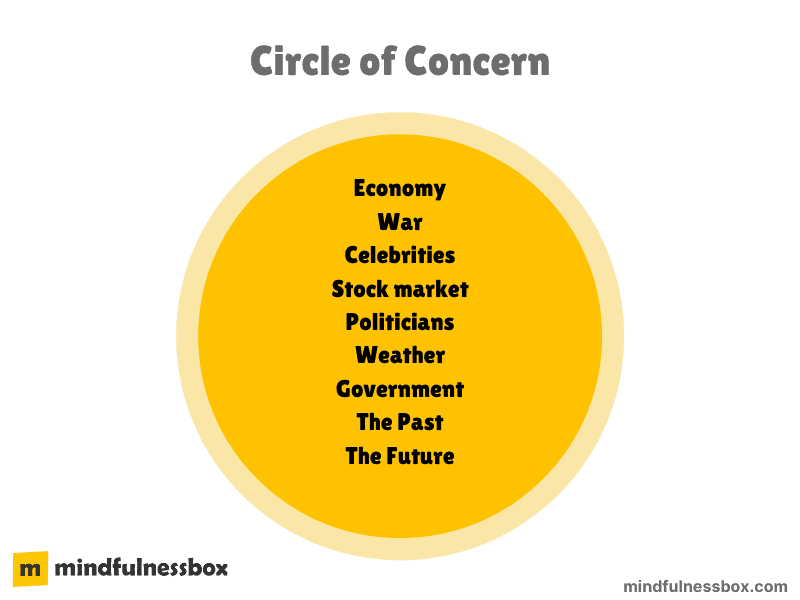
Circle of Concern Examples:
- What’s happening with the economy.
- Whether there’s a war going on.
- Who the latest celebrities are dating.
- What politicians are doing.
- What’s happening with the stock market.
- Whether it rains or not.
- What happened in the past.
- What will happen in the future.
Everyone’s Circle of Concern is different. We all care about different things.
And what might be in my Circle of Concern could be in your Circle of Influence. Maybe I’d love to accelerate the shift to plant-based meat, but as the CEO of a food company, you can actually do something about it. All I can do is eat veggie burgers when given the chance.
The Circle of Concern is where our energy tends to be wasted when we’re not careful. Scrolling through the news or watching endless YouTube clips about an issue doesn’t do much for anyone, other than make you stressed and anxious.
Your task here is to identify whether there’s something you can do within your Circle of Influence or Circle of Control. This is easier said than done, but raising the question is important. Otherwise, you risk falling into the trap of tying your happiness and peace of mind to an issue that might not be resolved for decades.
Climate change? Animal rights? Government corruption?
People more influential than you or me have been working on those for decades.
You might be able to make a donation, volunteer, influence your friends and family. You may also be able to make changes in your own life to support these causes. But invite yourself to set aside worries beyond that.
What is your Circle of Influence?

Your Circle of Influence includes everything that your actions can have an impact on.
Examples include the beliefs and behaviors of your friends and family, what’s happening in your immediate neighborhood, the causes you donate to, the people you vote for, and the way your wider network and platforms of influence, such as social media.
Here’s what it looks like for many of us:
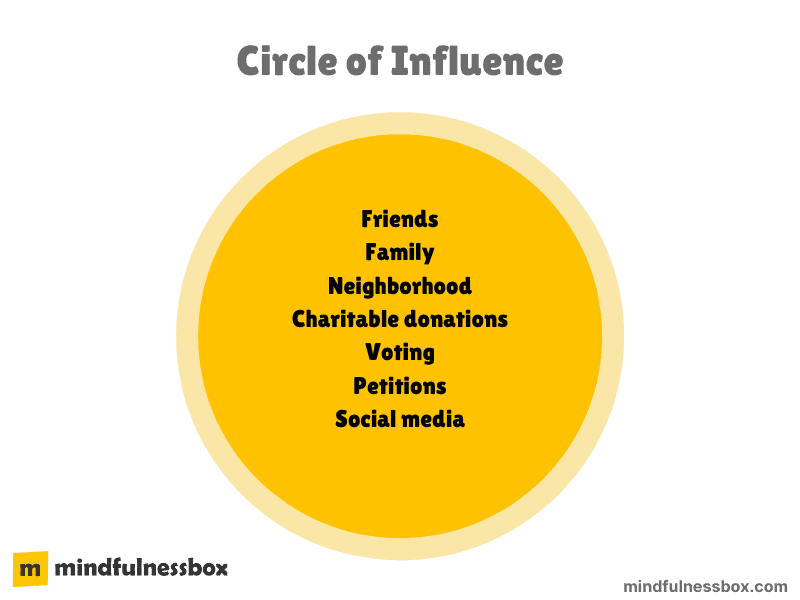
Circle of Influence Examples:
- Signing petitions and voting
- Your ability to amplify your voice on social media
- Making charitable donations to causes you care about
- You can influence (but not control) your friends and family.
Shifting your focus to the Circle of Influence doesn’t mean you have to entirely ignore bigger issues you care about.
You get to decide how involved you want to be on the things you care about. That might mean making donations, influencing your friends and family, starting initiatives in your neighborhood, or starting campaigns on social media.
Focusing on those actions (rather than on larger global issues that are out of your influence) can help give you the feeling that your day-to-day life is in your control, rather than something that’s happening to you.
This even applies to the ways you want to change yourself.
Let’s say you want to be a happier and more peaceful person.
That’s certainly within your Circles of Influence.
Unfortunately, you can’t flip a switch and make those big changes within yourself overnight. What you can do is work towards your goal over time by taking actions that you do have complete control over.
That’s where the Circle of Control comes in.
The Circle of Control
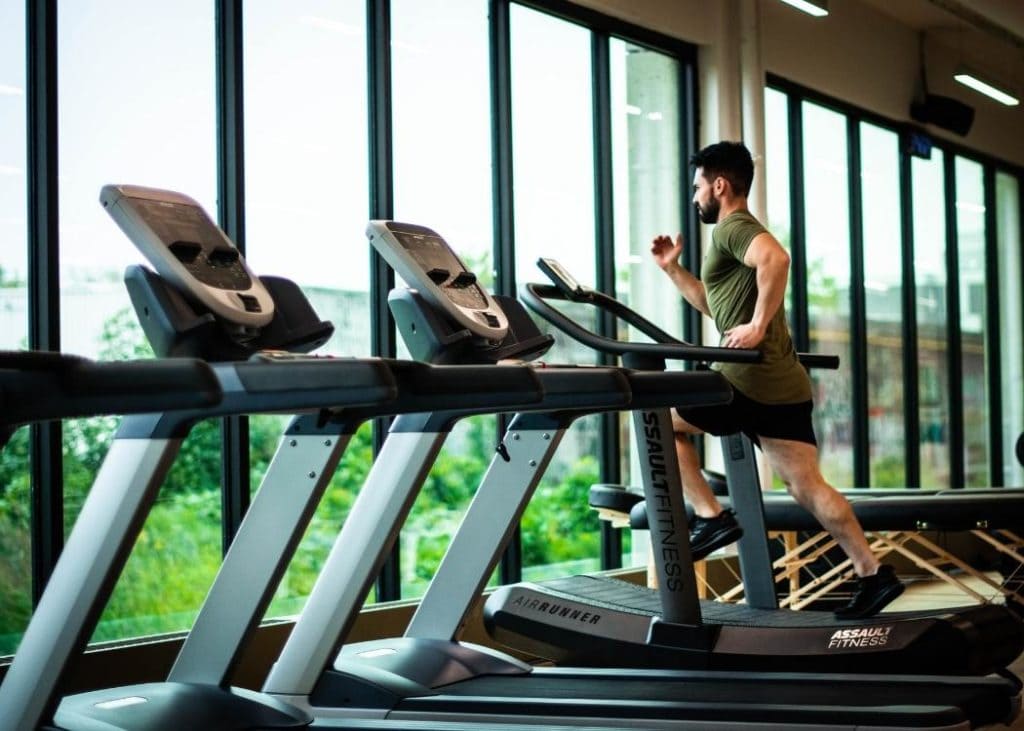
The Circle of Control are those areas in your life where you have 100% autonomy. For most adults, this includes where you live, what you wear, what you eat, what job you choose to do—all the elements that make up the external landscape of your life.
Here’s what it might look like for most of us:
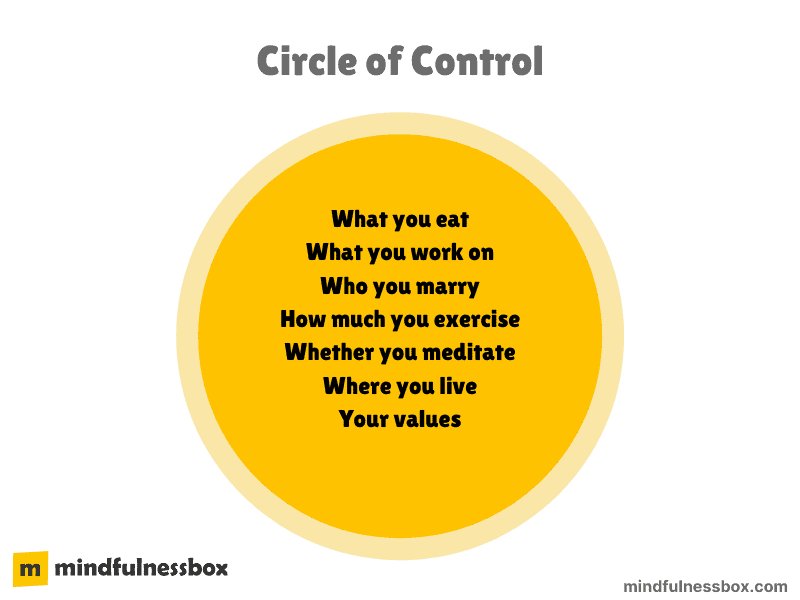
Circle of Control Examples:
- What you eat
- What you work on
- Who you marry
- How much you exercise
- Whether you meditate
- Where you live
- What your values are
Of course, some people don’t have autonomy over these aspects of their lives.
Victor Frankl’s excellent book Man’s Search for Meaning comes to mind here (to take an extreme example). In the book, Frankl recounts how even in the midst of the holocaust, he was able to survive by focusing on the purpose and meaning he chose for himself.
This was despite being a prisoner who had no control over what he ate, where he lived, what he did each day, or whether he would be killed on any given day.
Even in a case like Victor Frankl’s, you still have control over your internal landscape. Your circle of control includes your attitude, values, the thoughts you think, and the purpose you choose for yourself.
The power of the Circle of Control is that focusing here can lead to a feeling of greater effectiveness, autonomy, and purpose in your life.
Focus on your Circle of Influence and Circle of Control
I’ll take a moment to confess something.
Despite writing this article, part of me still feels like I should still be able to focus on the things I can control and influence, while also reading the news and spending energy staying informed about issues that matter to me in the world.
And certainly, a little bit of that is inevitable.
But the key is to keep your Circle of Concern small.
My big takeaway from Stephen Covey’s principle is that the vast majority of your effort and attention needs to go towards things you can control or influence.
If you’re spending half of your time reading about global events that you can never have a meaningful impact on, you’re reducing your ability to take actions in areas you can actually make an impact.
You only have so much time and energy, after all.
Save it for what you can influence.
Frequently asked questions
Who is in your Circle of Influence?
The people in your Circle of Influence are your friends and family. You can also influence your neighborhood and immediate surroundings. The Circle of Influence is different for everyone.
For example, if you own a company, it includes your employees, customers, and possibly your competitors, too. If you’re the principal of a school, your students are within your Circle of Influence.
Can you expand your Circle of Influence?
Yes. By focusing on actions you can control, you can expand your Circle of Influence over time. If you take actions that grow your personal and professional network, you’ll have an influence over more people.

My mindfulness practice kicked off in 2016 with a ten-day silent retreat. Since then, I’ve read dozens of books about mindfulness and completed hundreds of hours of meditation. Thinking about what makes humans happy, calm, and peaceful is endlessly fascinating to me.

